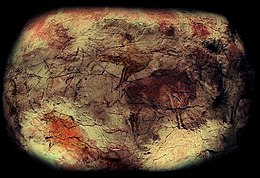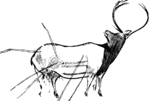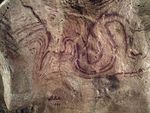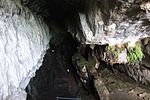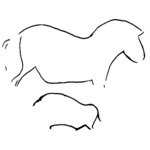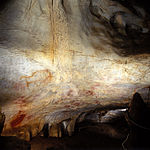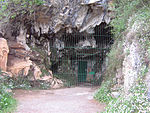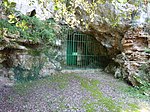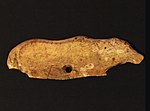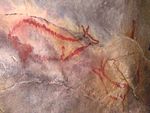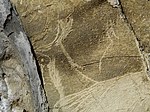From Wikipedia, the free encyclopedia
Cave with prehistoric art
Map of Paleolithic cave art sites in the Franco-Cantabrian region . The Cave of Altamira and Paleolithic Cave Art of Northern Spain (Cueva de Altamira y arte rupestre paleolítico del Norte de España Spain , which together represent the apogee of Upper Paleolithic cave art in Europe between 35,000 and 11,000 years ago (Aurignacian , Gravettian , Solutrean , Magdalenian , Azilian ). In 2008, they were collectively designated a World Heritage Site by UNESCO .
Chief among these caves is Altamira , located within the town of Santillana del Mar in Cantabria . It remains one of the most important painting cycles of prehistory , originating in the Magdalenian and Solutrean periods of the Upper Paleolithic. This cave's artistic style represents the Franco-cantabrian school, characterized by the realism of its figural representation. Altamira Cave was declared a World Heritage Site in 1985. In 2008, the World Heritage Site was expanded to include 17 additional caves located in three autonomous communities of northern Spain: Asturias , Cantabria and the Basque Country .
Code
Name
Location
Coordinates
Buffer zone
310-001
Cueva de Altamira
Cantabria , Santillana del Mar
43°22′57″N 04°07′13″W / 43.38250°N 4.12028°W / 43.38250; -4.12028 16 ha
310-002
Cueva de la Peña de Candamo
Asturias , Candamo , San Román
43°27′21″N 6°4′21″W / 43.45583°N 6.07250°W / 43.45583; -6.07250 100 ha
310-003
Cueva de Tito Bustillo
Asturias , Ribadesella
43°27′39″N 5°4′4″W / 43.46083°N 5.06778°W / 43.46083; -5.06778 243 ha
310-004
Cueva de La Covaciella
Asturias , Cabrales
43°19′5″N 4°52′30″W / 43.31806°N 4.87500°W / 43.31806; -4.87500 11.3 ha
310-005
Cueva de Llonín
Asturias , Peñamellera Alta
43°19′50″N 4°38′43″W / 43.33056°N 4.64528°W / 43.33056; -4.64528 17.4 ha
310-006
Cueva del Pindal
Asturias , Ribadedeva
43°23′51″N 4°31′58″W / 43.39750°N 4.53278°W / 43.39750; -4.53278 69.4 ha
310-007
Cueva de Chufín
Cantabria , Rionansa
43°17′26″N 4°27′29″W / 43.29056°N 4.45806°W / 43.29056; -4.45806 16.7 ha
310-008
Cueva de Hornos de la Peña
Cantabria , San Felices de Buelna
43°15′40″N 4°1′47″W / 43.26111°N 4.02972°W / 43.26111; -4.02972 25 ha
310-009
Cueva de El Castillo
Cantabria Puente Viesgo , Cantabria
43°17′33″N 3°57′56″W / 43.2924°N 3.9655°W / 43.2924; -3.9655 69 ha
310-010
Cueva de Las Monedas
Cantabria , Puente Viesgo
43°17′20″N 3°58′03″W / 43.289°N 3.9675°W / 43.289; -3.9675 69 ha
310-011
Cueva de La Pasiega
Cantabria , Puente Viesgo
43°17′20″N 3°57′58″W / 43.289°N 3.966°W / 43.289; -3.966 69 ha
310-012
Cueva de Las Chimeneas
Cantabria Puente Viesgo
43°17′29″N 3°57′52″W / 43.2914°N 3.9644°W / 43.2914; -3.9644 69 ha
310-013
Cueva de El Pendo
Cantabria , Camargo
43°23′17″N 3°54′44″W / 43.38806°N 3.91222°W / 43.38806; -3.91222 64 ha
310-014
Cueva de La Garma
Cantabria , Ribamontán al Monte
43°25′50″N 3°39′57″W / 43.43056°N 3.66583°W / 43.43056; -3.66583 100 ha
310-015
Cueva de Covalanas
Cantabria , Ramales de la Victoria
43°14′44″N 3°27′08″W / 43.24556°N 3.45222°W / 43.24556; -3.45222 1374 ha
310-016
Cueva de Santimamiñe
País Vasco , Vizcaya , Cortézubi
43°20′47″N 2°38′12″W / 43.34639°N 2.63667°W / 43.34639; -2.63667 99 ha
310-017
Cueva de Ekain
País Vasco , Guipúzcoa , Deva
43°14′09″N 02°16′31″W / 43.23583°N 2.27528°W / 43.23583; -2.27528 14.6 ha
310-018
Cueva de Altxerri
País Vasco , Guipúzcoa , Aia
43°16′7″N 02°08′02″W / 43.26861°N 2.13389°W / 43.26861; -2.13389 15 ha
Cave of Altamira and Paleolithic Cave Art of Northern Spain (unesco.org)Pike, A. W. G.; Hoffmann, D. L.; Garcia-Diez, M.; Pettitt, P. B.; Alcolea, J.; De Balbin, R.; Gonzalez-Sainz, C.; de las Heras, C.; Lasheras, J. A.; Montes, R.; Zilhao, J. (14 June 2012). "U-Series Dating of Paleolithic Art in 11 Caves in Spain". Science . 336 (6087): 1409–1413. Bibcode :2012Sci...336.1409P . doi :10.1126/science.1219957 . PMID 22700921 . S2CID 7807664 .
310-001: Altamira (Santillana del Mar)310-002: La Peña de Candamo (Candamo)310-003: Tito Bustillo (Ribadesella)310-004: Covaciella (Cabrales)310-005: Llonín (Peñamellera Alta)310-006: El Pindal (Ribadedeva)310-007: Chufín (Rionansa)310-008: Hornos de la Peña (San Felices de Buelna)310-009: Monte Castillo - El Castillo (Puente Viesgo)310-010: Monte Castillo - Las Monedas (Puente Viesgo)310-011: Monte Castillo - La Pasiega (Puente Viesgo)310-012: Monte Castillo - Las Chimeneas (Puente Viesgo)310-013: El Pendo (Camargo)310-014: La Garma (Ribamontán al Monte)310-015: Covalanas (Ramales de la Victoria)310-016: Santimamiñe (Kortezubi)310-017: Ekain (Deba)310-018: Altxerri (Aia)
North West Flag of Spain North East Centre East South Balearic Islands Canary Islands
1 Shared with other region/s 2 Shared with France 3 Shared with Slovenia 4 Shared with Portugal 5 Shared with Albania , Austria , Belgium , Bosnia and Herzegovina , Bulgaria , Croatia , Czech Republic , France , Germany , Italy , North Macedonia , Poland , Romania , Slovakia , Slovenia , Switzerland and Ukraine
Austria Belgium Bosnia Bulgaria Croatia Cyprus Czech Republic Finland France Germany Gibraltar Greece Hungary Italy Jersey Kosovo Luxembourg Malta North Macedonia Norway Poland Portugal Romania Russia Serbia Slovakia Slovenia Spain Switzerland Ukraine United Kingdom
Afghanistan Armenia Azerbaijan Cambodia China East Timor Georgia India Indonesia Iran Iraq Israel Japan Jordan Laos Lebanon Malaysia Mongolia Myanmar Pakistan Palestine Philippines Sri Lanka Thailand Turkmenistan Turkey Uzbekistan Vietnam
Algeria Botswana Cameroon DR Congo Egypt Kenya Lesotho Libya Morocco Mozambique Namibia Nigeria Somaliland South Africa Tanzania Uganda Zambia Zimbabwe
Argentina Aruba Belize Brazil Canada Chile Colombia Cuba Curaçao Dominican Republic Jamaica Mexico Peru Suriname United States
